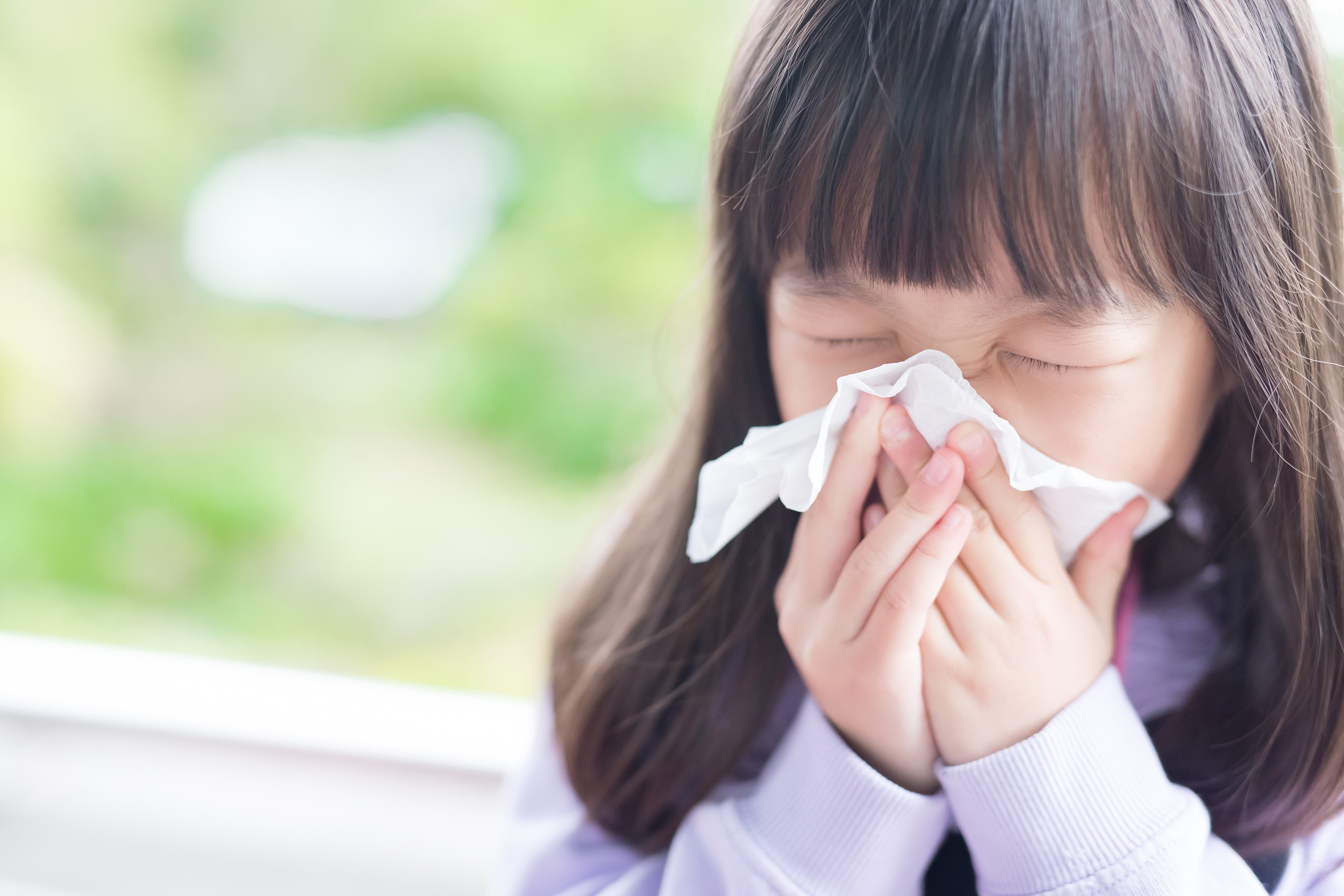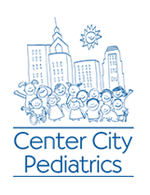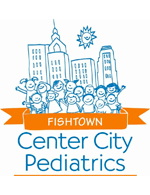Updated for common cold season 2018! Our Center City and Main Line pediatricians provide the facts on the common cold and the best cold remedies for kids.

While upper respiratory infections (common cold) may occur all year-round, it may seem like your child has had constant cold symptoms from October to April! It may not be your imagination: the average young child may have six to eight common colds a year, while those in group childcare may experience an even higher number. Feeling stressed? Don’t worry – we’ve got you covered!
What are the symptoms of an upper respiratory infection (URI)?
- Signs and symptoms of URI may include cough, sneezing, sore throat, nasal congestion, and runny nose.
- Fever (101F or higher in infants and children outside of the newborn period), if present, typically occurs in the beginning of a new URI, and is part of the immune response to fight infection.
- Malaise, fussiness, decreased appetite, and poor sleep may also occur.
- Duration of symptoms: Nasal congestion and runny nose will resolve in 90% of children within 15 days or less, while 90% of children will recover from cough symptoms within 25 days.
Myth buster! Yellow mucus means sinus infection?
Contrary to common opinion, yellow-green nasal mucus does NOT automatically indicate the presence of a bacterial infection. In most cases, it’s just a natural progression of the URI. If present, nasal discharge is typically clear and watery in the beginning of a cold, becomes a thicker white-yellow color as the body’s neutrophils (one of our body’s infection fighters) accumulate in the mucus. Nasal mucus typically turns yellow-green from the activity of these immune system fighters, then as the infection starts to resolve, gradually becomes clear again.
What causes upper respiratory infection?
- URIs are caused by viruses that enter the body either through inhalation of virus-containing aerosol (the mist generated from coughs or sneezes), or by picking up a virus on our hands (through touching contaminated surfaces like cell phones, door knobs, computer keyboards, toys) and touching our nose or eyes.
- Just how many viruses are there? Respiratory syncytial virus (RSV), rhinovirus, adenovirus, influenza (flu), parainfluenza, coronavirus, and human metapneumovirus, just to name a few!
Will antibiotics help a cold?
- Antibiotics are designed to kill bacteria, and have no activity against viruses. URIs, however, have become a common cause of antibiotic misuse, likely due to the idea that by giving antibiotics, we are “doing something” rather than nothing.
- While antibiotics are useful when needed, they are also associated with risks of developing antibiotic resistance (when bacteria in our body learn to “outsmart” and survive the antibiotic), drug allergy, secondary infection (e.g. yeast infections), and adverse reactions. As with any medication, the benefits of administration should outweigh the risks. With viral infections, there is no benefit from antibiotics.
- Visit the Center for Disease Control & Prevention’s “Get Smart: Know When Antibiotics Work in Doctor’s Offices” for more information on which common infections may benefit from antibiotics, and which may not.
What about over-the-counter (OTC) kids cold medicine?
- It may come as a surprise that many OTC cough and cold medications marketed for children have not been proven to be safe nor effective in children. Adverse effects such as abnormal heart rhythm, high blood pressure, confusion, hallucinations, insomnia, and gastrointestinal upset are not uncommon, and are more likely to be seen in children under 6 years of age. Due to these safety concerns and lack of benefit, their use is discouraged in children under six years, and should be strictly avoided in children less than four years.
Which common cold home remedies for kids are best?
- Gentle nose blowing or saline drops with gentle nasal aspiration using a nasal aspirator device, to help relieve the symptoms of nasal congestion. For young babies having difficulty nursing or taking a bottle due to nasal congestion, clearing the nose prior to feedings may make things easier.
- Cool or warm-mist humidifier (avoid hot steam humidifiers due to risk of burns), to help moisten respiratory passages and humidify secretions. Remember to clean regularly to prevent bacteria and mold build-up!
- Honey has been shown in placebo-controlled trials to be beneficial in reducing cough frequency and severity, and is safe to use in children 1 year of age and older. Never give honey to children under 1 year, due to the risk of infant botulism. No need to buy expensive honey-based natural cough syrups – just use your table honey, given straight or mixed with warm fluid. Brush teeth afterwards if given right before bedtime!
- While fever itself is not harmful and is simply part of the immune response to fight infection, it may contribute to your children’s discomfort. If you feel this is the case, a weight-based dose of acetaminophen or ibuprofen may be given. Remember: Don’t treat the number on the thermometer – treat based on your child’s level of discomfort.
- Warm fluids and pain relievers (e.g. acetaminophen or ibuprofen) may be helpful for sore throat. For children at least four years of age, hard candies and lozenges may also be soothing.
- Rest and hydrate. Slow down the day and let your child’s energy level tell you when they’re ready to take on more. After all, the body is hard at work fighting that infection!
When to see a doctor for a cold
- Symptoms of respiratory difficulty (fast breathing rate, wheezing, increased work of breathing).
- Signs of dehydration (decreased urine output, reduced tears, reduced moisture level in the mouth).
- Persistent and significant ear discomfort, especially in the setting of a new fever.
- Persistent fever not showing signs of improvement in height or frequency over several days.
- Unsure? Check out our “When to Wait, When to Worry and When to Panic” piece.
How to prevent upper respiratory infections in the future
- Help your child to practice good hand hygiene before eating and after playing in common areas shared with others. Wash hands with soap and water or alcohol-based hand sanitizer for 20 to 30 seconds (or while singing the “Happy Birthday” song twice, for perfect timing!)
- Teach your child to “catch” his or her cough or sneeze with the upper sleeve instead of the hand. Even better, use a tissue if available!
- While we unfortunately have to develop immunity naturally by repeated infections with many different respiratory viruses, we do have a safe and effective vaccine to prevent one of the most serious causes of URI: influenza (flu). The influenza vaccine has been shown to reduce the risk of influenza and influenza-related complications (ear infections, pneumonia, hospitalization). The most effective timing for receiving the flu shot is before seasonal flu activity begins, so contact your child’s doctor to schedule an annual flu shot as early as possible. For more information on the influenza vaccine, check out this resource from the Vaccine Education Center of The Children’s Hospital of Philadelphia. For information on our next walk-in flu clinic for CCP patients, click here.
 33 Rock Hill Rd
33 Rock Hill Rd 1740 South Street
1740 South Street 2365 East York Street
2365 East York Street
[…] For most uncomplicated cases the symptoms of flu can be managed with rest, drinking lots of fluids, Tylenol or ibuprofen for relief of discomfort from fever/body aches, and tincture of time. For safe home remedies for nasal congestion, cough, and sore throat, see our blog on best cold remedies for kids. […]